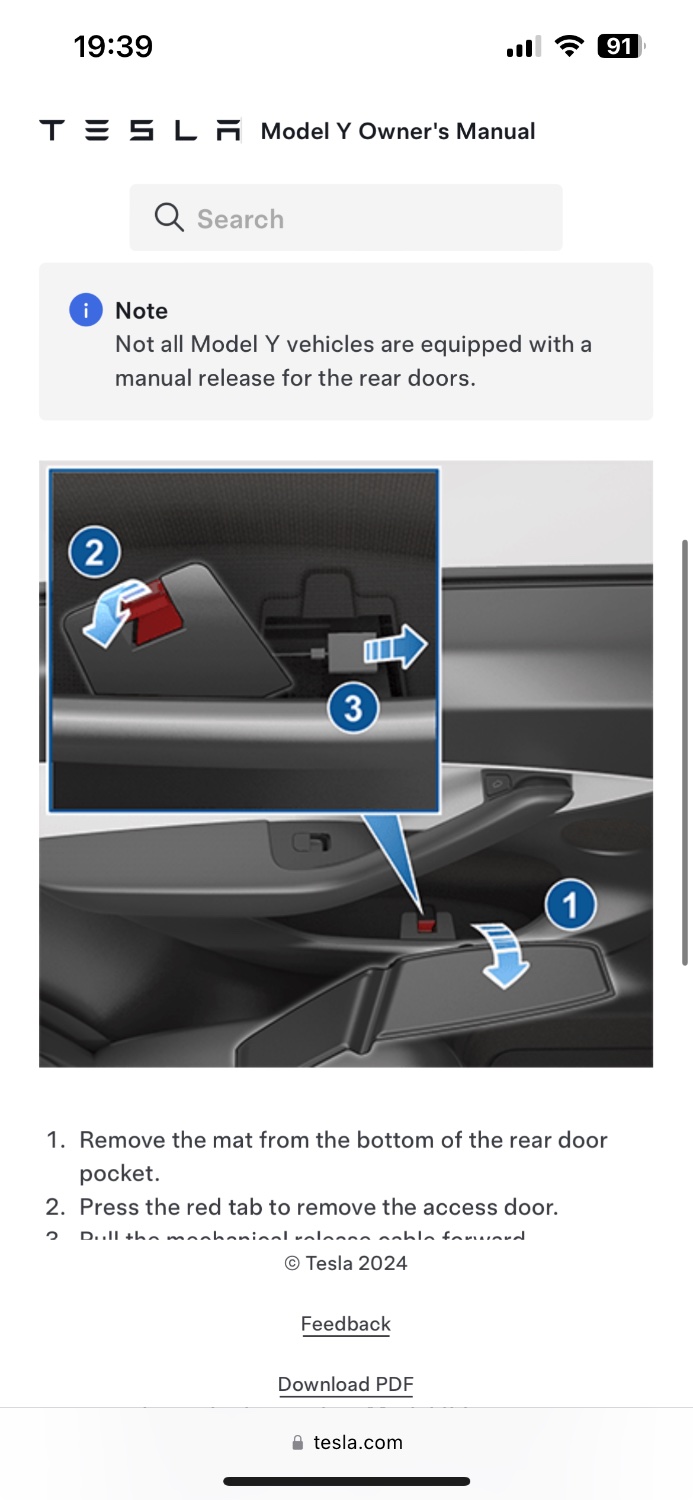

I’ve jokingly said this before, but just wait until manufacturers start adding 4G/5G to TVs explicitly for ads and telemetry…


I’ve jokingly said this before, but just wait until manufacturers start adding 4G/5G to TVs explicitly for ads and telemetry…


I’m going to upvote you for providing the viewpoint that models which have the manual releases hide them to prevent damage occurring from someone who instinctively pull on it to open the door. In the case of young children, they won’t know enough to not do the same thing they would do in other vehicles to open the door.
However, obscuring them from view also means they’re at high risk in the event of an accident which kills the power. Trying to calmly walk a child through the steps may not work. I don’t know how much force is needed for some of the release latches (and I’ll assume not a lot is required).


Cybertruck also has manual releases but the rear doors hold it in the map pocket. Better but still not in a sensible place when someone is panicking.


Ok. So that’s the Model 3.
How about the Model Y?

Ok. Not all Model Ys have rear manual releases. I’ll assume the best and believe that only certain countries have this design.
How about the Model X?

So it’s behind the speaker grille. Uncertain if you need a screwdriver, but I’ll assume not. However it is hidden away from sight.
How about the Model S?

Oh, it’s under the carpet.
So yeah, turns out, I’m not making shit up, and there is indeed empirical evidence for it.


I was talking to a Tesla owner about this and they argued that if the window is electric then there’s no difference making the door electric. They couldn’t understand that the door itself can be operated independently of the rest of the vehicle.
Making windows electric causes a safety tradeoff. You get ease of operation while losing the ability to open the window in the event of an accident (where power cannot be supplied). However you can still unlock and open the door manually as an alternative escape option. This also applies in non-accident scenarios (dead battery).
Making doors electric is nothing more than a safety risk. From the inside you might have access to a manual release latch, but some doors require you to unscrew things first. Any emergency situation where you need to exit as soon as possible and the power is lost almost guarantees that you’ll be unable to safely escape.


I’m worried about the security of this. However looking past that and simply observing it as an implementation of AI, this is an idea that I think is actually a beneficial use. Protecting the elderly against fraud/scams is a major issue which gets increasingly complex as scammers improve their methods. Using AI to detect scams in calls could be helpful in protecting the elderly.
But before rolling it out, I would want to see proof of its efficiency through careful studies. Hell, incentivize Google to share the model with the government and other businesses so it can be improved upon. Fund it as a grant/program so smaller teams/companies can contribute and innovate.


I think it would’ve been funny if the title was “StackOverflow contributors are revolting” and the comment was “a little more than usual.”
But hey, gotta get whatever amount of humor in while you can.


It’s not symmetrical yet though. Which is weird.
Eh, I would say it’s to be expected. A lot of infrastructure still relies on coax/DOCSIS which has its limitations in comparison to an all-fiber backbone. (This post has some good explanations.) However it wouldn’t surprise me if some ISPs argue that “nobody needs that much uplink” and “it helps restrict piracy” when really it’s just them holding out against performing upgrades.


Some of the jury candidate descriptions listed by the Washington Post seem to get a little too close to outlining some people’s identities.
For example:
The ninth prospective juror is a social media marketer for Fan Duel, a sports betting app. She watches sports and reality television and her father, brother and boyfriend work in finance. She uses Goole, Facebook, X, TikTok and Instagram.
(Emphasis mine)
It’s not incredibly specific but it’s enough information for motivated persons to use. I mean, it only takes her LinkedIn or Facebook profile to state she’s in New York and works for Fan Duel. Next thing you know, she’ll be getting death threats.
Having worked in classified areas, both as an admin and an unprivileged user, CDs were normally the method of transferring data up the network. (Transferring down rarely occurred, and even then you’d be limited to plaintext files or printouts.)
I’ve seen more places use data diodes to perform one- or two-way transfers so that requests can be streamlined and there’s no loose media to worry about tracking. It’s not super fast and higher speeds mean more expensive equipment, but it covers 98% of software update needs, and most non-admin file transfers were under 20MB anyways.
Anything that did require a USB drive, like special test equipment (STE) or BIOS updates, had to use a FIPS-140-1 approved drive that offered a ready-only mode via PIN. This drive could only be written to from a specific workstation that was isolated from the rest of the machines (where data was transferred via CDs of course) and required two persons to perform the job to ensure accountability.
Not the most time-efficient way of doing things, and not completely bulletproof, but it works well enough to keep things moving forward.